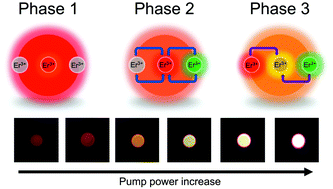Power-dependent photophysical pathways of upconversion in BaTiO3:Er3+†
Abstract
Lanthanide incorporated perovskite is one of the most promising systems for efficient energy conversion or light-emitting materials in terms of upconversion (UC). Investigation of the photophysical mechanism of UC in the lanthanide-doped system is here continued. However, research on the 4I13/2 energy state in Er3+ is rare and more is still needed. In our work, BaTiO3:Er3+ (E-BT) was irradiated by a 1532 nm laser which is a resonance to the energy between 4I13/2 and the ground 4I15/2 state in Er3+. Bright 1532 nm-pumped UC was generated, and the UC color changed from red to yellow under increasing laser power. In addition, pump-power-dependent UC contained interesting clues about the photophysical pathway of UC. By analyzing photon numbers for each UC (green: 2H11/2/4S3/2 → 4I15/2, red: 4F9/2 → 4I15/2, infrared: 4I9/2 → 4I15/2), we found that changes in photon number with pump-power increase contain three different phases (P). P1 is a red UC phase with a small cross-relaxation between Er3+ ions. However, in P2, there is a rapid decrease in the photon number with green UC generation, which is due to the enhancement of 4I13/2-populating cross-relaxation. Finally, in P3, a saturated 4I13/2 state causes little increase of photon number (compared with P2), with different mechanistic cross-relaxation enhancement. With these three different phases under 1532 nm pumping, photophysical mechanisms in E-BT are interpreted.



 Please wait while we load your content...
Please wait while we load your content...